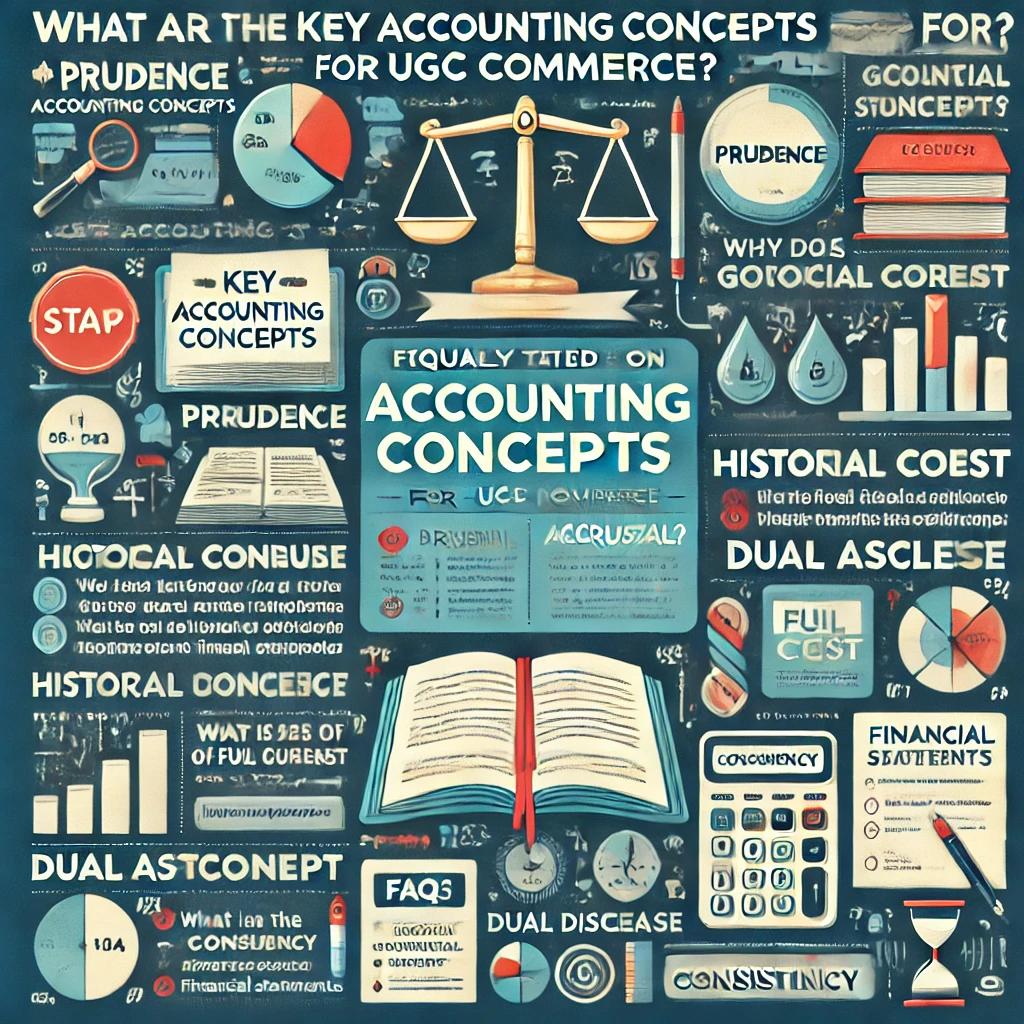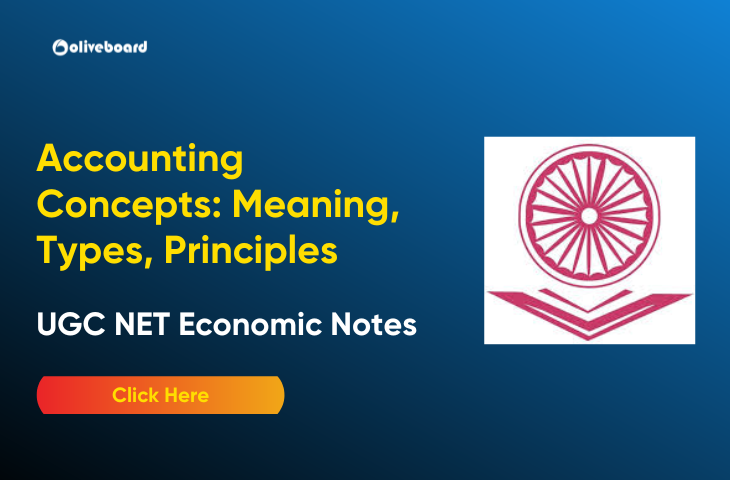Accounting concepts are the fundamental assumptions and principles that form the foundation of financial accounting. Understanding these concepts is crucial for students preparing for the UGC NET Commerce exam, as they provide the theoretical framework that underpins accounting practices. Key accounting concepts such as the Accrual concept, Going Concern concept, Consistency, and Prudence, among others, are essential for interpreting and analyzing financial data. This knowledge is not only foundational for the UGC NET Commerce exam but also critical for a career in accounting and finance.
Click Here to Check UGC NET Notification 2024
Meaning of Accounting Concepts
- Accounting concepts are the basic principles or assumptions that form the foundation for accounting practices.
- Guidelines for Financial Reporting: These concepts guide accountants in preparing financial statements that are accurate, consistent, and reliable.
- Consistency in Application: They ensure uniformity in the accounting process, making financial data comparable over time.
- Framework for Decision-Making: Accounting concepts provide a structured framework for making sound financial decisions and analysis.
- Basis for Accounting Standards: These concepts form the basis for various accounting standards, such as GAAP or IFRS, ensuring global consistency.
Types of Accounting Concepts
1. Accrual Concept
- The accrual concept dictates that revenue and expenses should be recognized when they are earned or incurred, rather than when the cash is actually received or paid.
- Example: If a company delivers goods to a customer in December but receives payment in January, the revenue is recognized in December when the goods are delivered, not in January when cash is received.
2. Going Concern Concept
- The Going concern concept assumes that a business will continue its operations indefinitely, or at least for the foreseeable future.
- Example: A company might amortize an asset like machinery over several years under the going concern assumption. If the going concern assumption is in doubt, the company may have to adjust the valuation of its assets.
3. Consistency Concept
- According to the consistency concept, once an accounting method or principle is adopted, it should be consistently applied in subsequent periods unless a change is necessary and justifiable.
- Example: If a company uses the straight-line method of depreciation for its assets in one year, it should continue using that method in the following years unless a change is required or allowed by accounting standards.
4. Prudence (Conservatism) Concept
- The prudence concept requires that accountants exercise caution when making estimates and judgments, ensuring that expenses and liabilities are recognized as soon as they are probable, but revenues are only recognized when they are certain.
- Example: If a company anticipates a bad debt, it must record an allowance for doubtful accounts, even if the actual loss has not yet occurred.
5. Matching Concept
- The matching concept dictates that expenses should be recorded in the same period as the revenues they helped generate.
- Example: If a company incurs advertising costs in December to promote a product sold in January, the expense is matched with the revenue from the sale of the product in January, not in December.
6. Entity Concept
- The entity concept treats the business as a separate legal entity distinct from its owners or shareholders.
- Example: If a business owner withdraws money for personal use, this transaction is not recorded as a business expense; it is recorded as a drawing or withdrawal in the owner’s equity account.
7. Money Measurement Concept
- According to the money measurement concept, only transactions that can be expressed in monetary terms are recorded in the financial statements.
- Example: While a company might have loyal customers and skilled employees, these aspects are not recorded on the balance sheet because they cannot be quantified in monetary terms.
8. Cost Concept
- The cost concept requires that assets be recorded at their original cost (historical cost) rather than their current market value
- It ensures objectivity and verifiability because the original cost is a definite figure, while market values can fluctuate.
- Example: A company buys machinery for $100,000. Under the cost concept, the asset will be recorded at $100,000 on the balance sheet, even if its market value has increased to $120,000 by the end of the year.
9. Realization Concept
- The realization concept states that revenue should be recognized when it is earned, i.e., when goods are delivered or services are provided, rather than when cash is received.
- Example: If a company provides a service in December but receives payment in January, the revenue is recognized in December when the service was performed, not in January when the payment is received.
10. Dual Aspect Concept
- The dual aspect concept is the foundation of double-entry bookkeeping.
- Example:
- If a business takes out a loan of $10,000, it receives cash (an asset) and incurs a liability (loan payable).
- Both the debit and credit are recorded, maintaining the balance in the accounting equation.
Principles of Accounting
- Revenue Recognition Principle: Revenue is recorded when earned, not when cash is received.
- Matching Principle: Expenses are matched with the revenue they generate in the same period.
- Cost Principle: Assets are recorded at their historical cost, not their market value.
- Conservatism Principle: Recognize expenses and liabilities early, but only record revenues when certain.
- Full Disclosure Principle: All relevant financial information should be disclosed in financial statements.
- Consistency Principle: The same accounting methods should be applied consistently over time.
- Monetary Unit Principle: Financial transactions are recorded in a stable currency.
- Economic Entity Principle: The business’s financial activities are separate from its owners’ personal activities.

Application of Accounting Concepts
Some of the application of accounting concepts:
1. Accrual Concept
- Application:
- Revenue and expenses are recorded when earned or incurred, not when cash is exchanged.
- Example: a company delivering goods on credit records the revenue when the goods are delivered, not when the customer pays.
2. Going Concern Concept
- Application:
- Businesses prepare their financial statements under the assumption that they will continue operating indefinitely.
- Example: Depreciation on assets is calculated based on their useful life, assuming the business will continue using these assets.
3. Consistency Concept
- Application:
- Once an accounting method is chosen, it should be applied consistently across periods.
- Example: if a company uses the straight-line method of depreciation, it must continue using this method unless there is a valid reason to change.
4. Prudence (Conservatism) Concept
- Application:
- Expenses and liabilities are recognized as soon as they are likely to occur, while revenues are recognized only when they are assured.
- Example: Estimated loss from a pending lawsuit is recorded as a liability, even before the court’s decision.
5. Matching Concept
- Application:
- Expenses are recorded in the same period as the related revenues.
- Example: if a company incurs advertising costs in December to generate sales in January, the cost is matched with the sales revenue in January.
6. Entity Concept
- Application:
- The financial transactions of the business are kept separate from those of its owners.
- Example: if an owner withdraws money from the business for personal use, this is recorded as a drawing and not as a business expense.
7. Money Measurement Concept
- Application:
- Only transactions that can be measured in monetary terms are recorded in the financial statements.
- Example: goodwill and customer loyalty, although valuable, are not recorded unless they can be quantified in monetary terms.
8. Cost Concept
- Application:
- Assets are recorded at their historical cost.
- Example: if a company buys machinery for $10,000, it is recorded at that cost, even if its current market value has changed.
9. Realization Concept
- Application:
- Revenue is recognized when it is earned, not when cash is received.
- Example: a sale is recorded when the product is delivered to the customer, not when the payment is received.
10. Dual Aspect Concept
- Application:
- Every transaction affects at least two accounts, maintaining the balance in the accounting equation (Assets = Liabilities + Equity).
- Example: if a business borrows $5,000, it records an increase in both cash (asset) and loan payable (liability).
Accounting Concepts Conclusion
The application of UGC NET accounting concepts such as prudence, accrual, going concern, historical cost, full disclosure, dual aspect, and consistency forms the foundation of UGC NET Commerce financial reporting. Assets are recorded at their original cost, and full transparency in financial disclosures is required. The dual aspect principle ensures each transaction affects at least two accounts, maintaining balance, while consistency in accounting methods is crucial for reliable financial statements. Understanding these UGC NET accounting principles helps aspirants excel in UGC NET Commerce exams by providing a structured approach to accounting concepts essential for the exam’s theoretical and practical sections.
UGC NET MCQ based on Accounting Concepts
Q1. The concept that requires recognizing expenses in the same period as the revenue they generate is known as:
a) Prudence Concept
b) Matching Concept
c) Entity Concept
d) Full Disclosure Concept
Ans: b) Matching Concept
Q2. Which accounting concept requires that all known liabilities should be recorded, but potential revenues should not be recognized until they are reasonably certain?
a) Consistency Concept
b) Prudence (Conservatism) Concept
c) Accrual Concept
d) Realization Concept
Ans: b) Prudence (Conservatism) Concept
Q3. Under the Consistency Concept, a company is required to:
a) Apply the same accounting policies over time, unless there is a sound reason for a change.
b) Use different accounting policies for different types of assets.
c) Disclose any change in accounting policy only if it affects the current period.
d) Maintain consistency only in the income statement, not the balance sheet.
Ans: a) Apply the same accounting policies over time, unless there is a sound reason for a change.
Ans: The key accounting concepts for UGC NET Commerce include prudence, accrual, going concern, historical cost, full disclosure, dual aspect, and consistency.
Ans: The accrual concept in UGC NET Commerce dictates that revenues and expenses are recognized when earned or incurred, not when cash is exchanged. This principle ensures accurate financial reporting, which is essential for UGC NET exams.
Ans: To study these accounting concepts for UGC NET, refer to textbooks, study guides, and online resources focused on UGC NET Commerce topics, as well as practice papers that cover financial reporting and accounting principles.

Hello there! I’m a dedicated Government Job aspirant turned passionate writer & content marketer. My blogs are a one-stop destination for accurate and comprehensive information on exams like Regulatory Bodies, Banking, SSC, State PSCs, and more. I’m on a mission to provide you with all the details you need, conveniently in one place. When I’m not writing and marketing, you’ll find me happily experimenting in the kitchen, cooking up delightful treats. Join me on this journey of knowledge and flavors!
